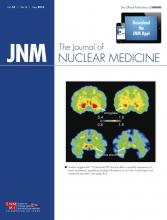REPLY: We wish to thank Dr. Buxton for his letter to the editor, describing the effects of red blood cell uptake (plasma–to–whole-blood activity ratio) and transport/phosphorylation of 18F-FDG versus glucose (lumped constant [LC]) for accurate quantification of the rate of myocardial glucose uptake (rMGU) in mice. Our study (1) showed that the image-derived blood input function (IDIF) within a region of interest in the mouse vena cava can be used for repeatable assessment of the blood time–activity curve for Patlak kinetic modeling of rMGU in healthy control Friend virus B–type mice. We also demonstrated the utility of this methodology to detect serial changes of rMGU in streptozotocin-induced type 1 diabetic mice at baseline, after diabetes induction, and after acute insulin treatment. The small size of the mouse LV cavity, on the order of the spatial resolution of the current small-animal PET imaging systems, results in substantial myocardial activity spillover into the mouse left ventricular cavity region and inaccurate assessment of the blood IDIF.
In this paper we assumed an LC of 0.67 for estimation of myocardial glucose uptake, according to previous 18F-FDG measurements in mongrel dog hearts (2). The reported LC values in mouse 18F-FDG studies range from 0.6 to 1.0 (3,4). We agree that more research is needed to verify the accuracy of LC values for mouse 18F-FDG studies in relation to blood glucose levels and organ blood flow, potentially using methods such as those proposed by Wiggers et al. (5). These studies will need to control for multiple variables such as fed versus fasted versus glucose-clamp state, disease model or phenotype, background strain of the mouse, and anesthetic protocol, all of which can affect the LC value. The particular assumed LC value in our study determines the absolute scale of the rMGU values but does not change the relative (%) values of test–retest repeatability or population variability as reported.
It is true that the LC may be reduced in the type 1 diabetic model compared with both baseline and acute insulin treatment. As reported in Schuier et al. (6), the LC for the brain in rats decreased very gradually with increasing plasma glucose concentration, from 0.45 at normoglycemic range (7–8 mM) to 0.38 at hyperglycemic range (28–31 mM). If the same effect was assumed to occur in the mouse heart, this would reduce the reported difference in rMGU between baseline and type 1 diabetes by about 15% (although there are no data to confirm or refute this assumption). Because the reported diabetic rMGU was reduced by 60% versus baseline, the observed reduction would still be significant, demonstrating the utility of the vena cava IDIF for precise serial estimation of the rMGU in this mouse model of diabetic disease and therapy, using each animal as its own control.
Although the plasma time–activity curve may be more accurate to determine the absolute rMGU values, the primary goal of the present study was to confirm the validity of the sampled arterial whole blood versus the IDIF. It is not possible to directly measure plasma concentrations from the whole-blood regions of interest on the PET image; therefore, we agree that plasma–to–whole-blood corrections should ideally be performed. Similar to the LC effects described above, additional studies may be required to fully characterize the effects of variable red blood cell uptake on rMGU values in mice. Assuming these effects are small between experimental conditions using the same species, strain, diet, anesthetic, and other variables, we are proposing methodology that is similar to what has been used in clinical studies, allowing for the potential translation of serial rMGU PET imaging from mouse models to application in evaluation of disease phenotype and therapy in human patients.
Footnotes
Published online Mar. 20, 2014.
- © 2014 by the Society of Nuclear Medicine and Molecular Imaging, Inc.







